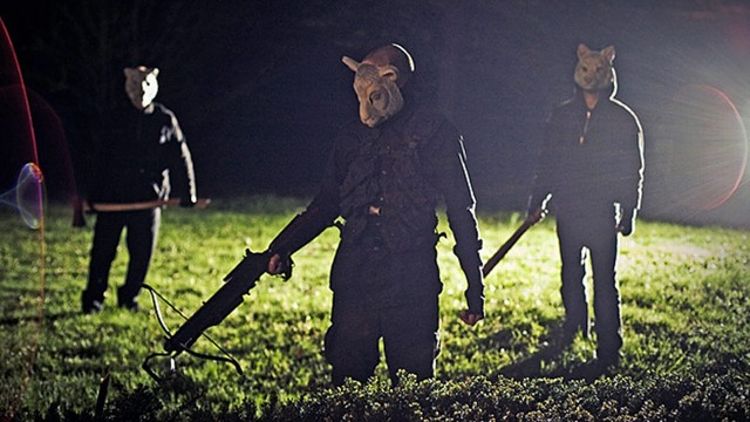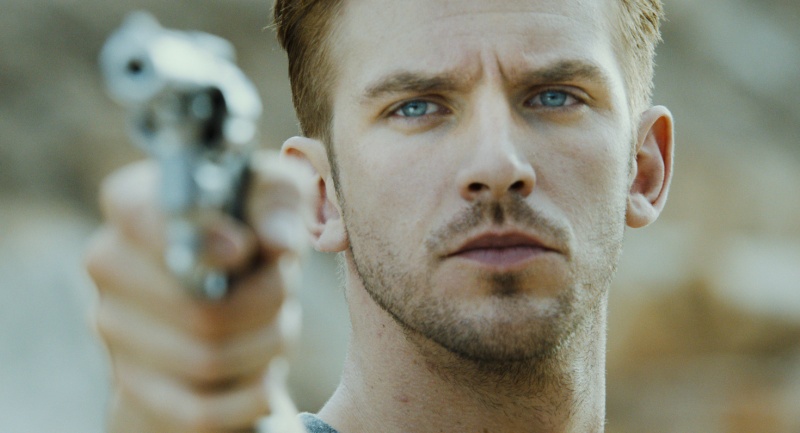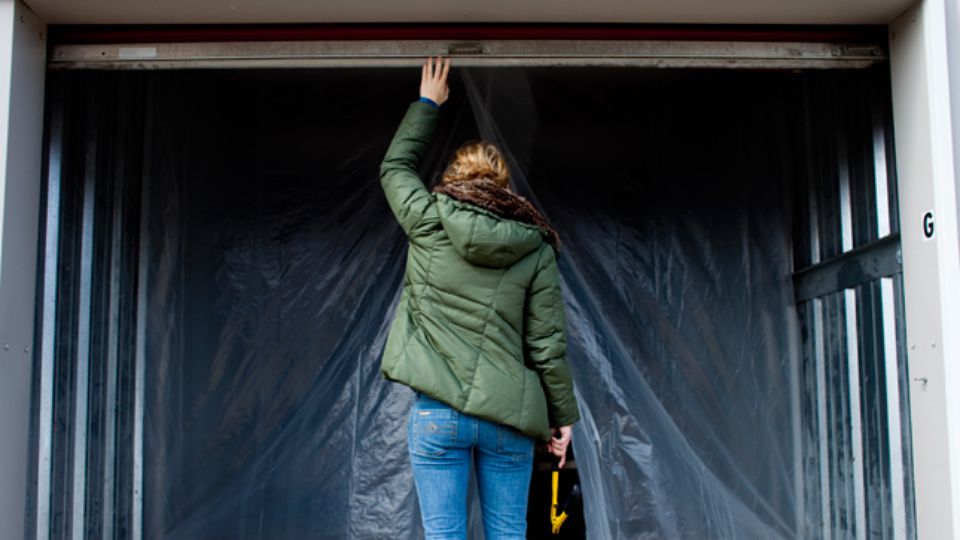There aren’t many famous scriptwriters in the horror community, but Simon Barrett is undoubtedly one. Starting with the (in)famous Frankenfish, Barrett’s character-centric approach to the genre (especially with his long-time collaborator Adam Wingard) have become critical faves, with You’re Next and The Guest making many best-of and end-of-year lists. The first time I interviewed him for the Austin Chronicle was at Fantastic Fest in 2010, when he had just won the best script award for his radical new take on the serial killer genre, A Horrible Way to Die. The impromptu interview took place in the hallway at the Alamo South Lamar.
Richard Whittaker: It’s a pretty unique take on serial killers: Where did the story come from?
Simon Barrett: We got a couple of false starts of trying get projects financed that [Adam] would direct and I would write and produce, and he was getting kinda frustrated. He’d say, ‘Serial killer movies always get made,’ and I was like, ‘I don’t want to write a serial killer movie.’ I don’t like most of them, and between Se7en and Zodiac, David Fincher‘s said all there is to say on that subject. They’re all either procedurals or ‘inside the mind of a psychopath,’ which I don’t enjoy and I don’t think it’s possible to do effectively.
But he started talking about Ted Bundy, and how he escaped from prison and was thought to be hunting for his ex-girlfriend. That got me thinking about something that excited me, which is the idea of addictive love, and that serial killers are real people with parents and ex-girlfriends. If your kid grows up to be a serial killer, how do you trust a decision you’re going to make ever again? And if your ex-boyfriend turns out to be a serial killer, what’s it going to be like if you ever start dating again? Can you trust another human being?
RW: That aspect of the serial and spree killer phenomenon has been dealt with in books and autobiographies before, but not film.
SB: To put it very succinctly, what excited me about making a movie that features a serial killer as a character is the personal aftermath. When you have an addiction like killing people, it’s going to end badly, and the aftermath of that discovery and how it would affect a person’s self-view. I was trying to imagine to imagine what that’s like and trying to humanize those moments.
RW: How important was it to get AJ Bowen in place as Garrick Turrell, the killer with a conflicted conscience?
SB: AJ will tell you, he was the final piece of the cast to fall in place. He had been someone we were talking about that we’d assumed we couldn’t get because of the budget of the film and his schedule. It was our friend Evan, who lives around here and went out drinking with AJ and happened to talk up what we were doing. He called us up and said, ‘I think AJ Bowen would be in your movie.’ So we sent up and some of Adam’s short films and the script, and he said yes.
(in 2011, I heard Wingard and Barrett were going to be back at Fantastic Fest with You’re Next, their take on the home invasion thriller. I managed to get a quick call in to them in Toronto, after the film had sparked a bidding war between distribution houses.)
 “I don’t like serial killer movies.” An odd confession from writer/producer Simon Barrett, considering he picked up best horror screenplay for arthouse stalker film A Horrible Way To Die at Fantastic Fest 2010. A year later, he and director Adam Wingard are back with You’re Next, their take on the home invasion trope. And guess what? It is another genre that often annoys him. He says: “The films that inspire me are not films that I like, but films that I dislike. I see them, and I start to think, ‘How would I do that differently?’ or ‘How can that be done better?’ or ‘I’ve seen that so many times – what’s a new way to do that?'”
“I don’t like serial killer movies.” An odd confession from writer/producer Simon Barrett, considering he picked up best horror screenplay for arthouse stalker film A Horrible Way To Die at Fantastic Fest 2010. A year later, he and director Adam Wingard are back with You’re Next, their take on the home invasion trope. And guess what? It is another genre that often annoys him. He says: “The films that inspire me are not films that I like, but films that I dislike. I see them, and I start to think, ‘How would I do that differently?’ or ‘How can that be done better?’ or ‘I’ve seen that so many times – what’s a new way to do that?'”
The project’s genesis came out of touring the festival circuit with A Horrible Way To Die and seeing an endless stream of Straw Dogs wannabes. Barrett says: “Adam was into the idea of doing one because he finds them scary and intense, and again I was like, ‘I really don’t like a lot of them.’ I feel like the home invasion genre is still basically stuck doing the same thing that Funny Games was satirizing in 1997.” So instead of the same old gun-to-the-head, find-the-wall-safe pabulum, he added some screwball sensibilities, making it “this awesome chamber comedy. … Adam kept calling me and asking how intense and scary the script was going to be, because I think he was hoping for something atmospheric like The Strangers, and I kept just saying: ‘Er, I don’t know. I think it’s kind of funny.'”
Wingard has become synonymous with the horror end of mumblecore – a subgenre so fresh that it still does not have a nickname. (Mumblegore? Mumbledoom? The choice is yours.) He says, “From the get-go, I told Simon I wanted something that was more technical, something focused more on a sense of atmosphere and tension and action that I’d never done before.” That meant abandoning the radical, dreamlike sensibilities of his earlier films. Unlike the drug-dazed miasma of his debut, Pop Skull, You’re Next “is a film that takes place in one night, so everything had to be very precise,” he says. “Before, all my experimentations were about creating a unique cinematic language. For this one, the experiment was to see if I could utilize more conventional cinematic languages.”
If the script and the look break from Wingard’s earlier introspective work, that was exactly what he was looking for. But while You’re Next moves away from mumblecore’s cinema verité roots, it still draws deep from its talent pool. The Innkeepers‘ director Ti West gets a cameo, while Joe Swanberg (with whom Wingard co-directed Autoerotic), Amy Seimetz, and AJ Bowen are all back from A Horrible Way To Die. Barrett says, “We knew our next film would be much bigger, and we wanted to give them a bit of a reward, cast them in a movie where we could actually pay them a living wage.”
(You’re Next‘s release became a long, slow slog that has become an object lesson in the mercurial vicissitudes of indie filmmaking, but it didn’t slow down Barrett, who was back at Fantastic Fest in 2014 with The Guest. His riff on the ‘cuckoo in the nest’ trope had already played at SXSW, and was so popular that it violated the unspoken law that no film will play at two Austin festivals in the same year.)
 RW: So when was the point when you went, you know what, I’m going to do my own Universal Soldier?
RW: So when was the point when you went, you know what, I’m going to do my own Universal Soldier?
SB: You know what, it’s funny. Someone brought up Universal Soldier not too long ago, and Adam and I were like, oh yeah. … It was more going back to the very first films that inspired us to start making movies when we were really young. Going back to the original Halloween, even though that actually came out before we were born. Well, it didn’t come out much before I was born, maybe a couple of weeks. That movie, along with Bob Clark’s Black Christmas, the giallo films, especially Twitch of the Death Nerve, the slasher genre of the ’80s that was inspired by the success of John Carpenter’s Halloween. Those were the first films I watched obsessively enough to figure out what editing was, and what camera work meant, and how to make films. Of course, my version was a VHS camcorder that I was able to check out of the library was not on a par with John Carpenter’s work.
But I started imitating those movies, and obviously we don’t want to make anything that is explicitly imitative or a pastiche piece. We always try to be innovative and do things that we haven’t seen before and we haven’t done before. It was more Halloween, The Terminator – for me, Donald E. Westlake’s script for The Stepfather was a real touching point. I saw that pretty much when it came out. I was 10, 11 or so, maybe older, when it was on my neighbor’s HBO. I watched it a bunch, and was really into it, and really into the way that movie in particular manages to build suspense despite being called The Stepfather, and letting you know right away what’s going on. The details are so fascinating, because you never know exactly what Terry O’Quinn’s going to do in any of those scenes. That was the kind of film I wanted to make.
RW: I saw this and Faults at South By at the same time. Were you just on adjoining sets, because you share half the cast?
SB: The films were shot basically back to back, and we’re friends with Riley Stearns, who directed that film, and I’m a big fan of that film. But Keith Calder and Jess Calder produced both films, and it really was that they were casting Faults while we were shooting The Guest. So it really was, hey, you’re doing a good job, do you want to be in Faults. So it’s not just Leland Orser. Lance Reddick’s in there, AJ Bowen’s in there.
RW: You follow the progression from Horrible Way to Die, through You’re Next, to this, and in your head you’re going, hm, can I give Adam more shit to blow up?
SB: I don’t know if Adam felt like he had enough shit to blow up. A lot of the stuff in that Peterson action house sequence, a lot of that was conceived by Adam walking through locations with me. We’ve never had the budget to build sets based on my scripts. It’s always been finding locations and reconfiguring the scene to make it work. So a lot of that is just him walking through with me and going, this can happen over here.
Blowing stuff up is hard and is time consuming, is what we discovered during this shoot. Honestly, we always wanted to blow stuff up, but we never had the money to do so. The literal first conversation I had with Adam was the Hong Kong cinema of the ’80s, early ’90s, and how much we loved those films. Specifically, John Woo’s The Killer was a huge reference point, and we’re talking about how that movie’s as good as it is. But we never could afford those squibs or grenade explosions that permeate Hard Boiled or Heroes Shed no Tears. We always wanted to make those kind of movies, but never had the resources. So after the success of You’re Next, The Guest was the first time we could do something a little more action oriented. We had the money to blow things up, and then we discovered that blowing things up is miserable and dangerous and really difficult.
RW: Plus you have to make sure that you have enough of whatever it is you’re blowing up to do it twice.
SB: During one of the shoot-out scenes, one of the prop wrangler guys comes over to me and says, I’m worried that we’re going to run out of bullets. I was like, you’ve got to be fucking kidding. How many bullets did you bring? He was like, 20,000. Oh, that seems like a very reasonable number. How many have we used? He’s like, we’re on take three, and we’ve spent 8,000 bullets. OK, I’m not even going to tell Adam that, because it’s just going to stress him out. Let me know when we’re at 18,000 bullets. Because I want Adam to get what he’s getting, and if he’s getting it, then I’m not going to go over and say, hey, can you have the guys fire less?
